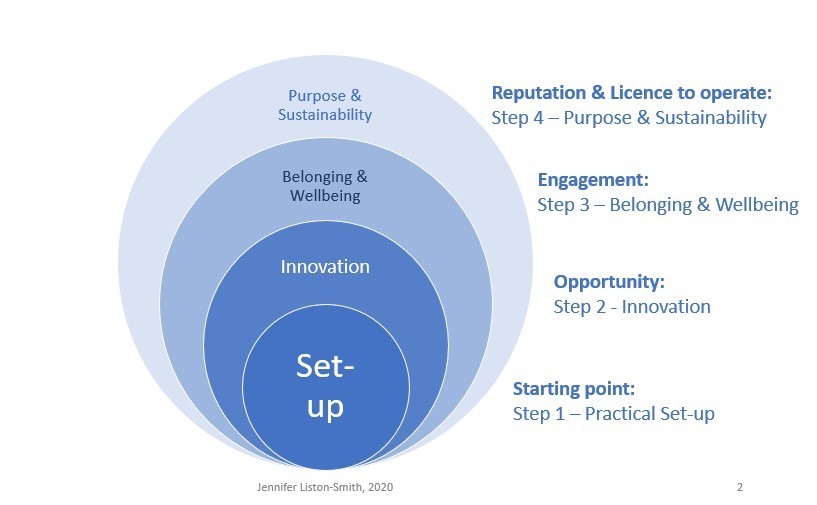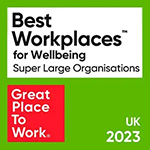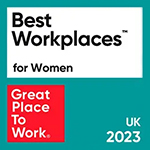Diversity & Inclusion as a Core Element of the New Normal
I’ve produced a few different checklists and models now, exploring what it might mean for all of us to lead in the New Normal.
This latest one I put together when the wonderful Tea Colaianni invited me to join the panel for one of WiHTL's webinars for HR leaders in the Hospitality, Travel & Leisure sector. I was asked to share some ideas on how employers (in any sector) can sustain our commitment to diversity and inclusion while planning the next phase.
I hope you’ll find it useful – let me know.
I spend a lot of my time now in thought leadership and corporate affairs but my roots are in leadership development and coaching psychology; exchanging ideas is an important catalyst in all of these.
Model for a Future-Focused Comeback

In this model, the first two layers are vital. A safe practical set-up is obviously indispensable and the second layer ought to feel unmissable since the window for innovation is open now, in a way that won’t be so true outside of this unusual time. The other point I wanted to venture with this model is that getting the set-up right might not count for much if our businesses do not have ongoing traction. That momentum, more than ever, will depend on our ability to rekindle a sense of belonging and wellbeing and also through our social licence to operate afforded by a strong senseof purpose and visible commitment to sustainability.
Two vital first layers:
1. Practical set-up
This includes: safe workspaces / effective working from home, effective collaboration to reinstate supply chains, transportation considerations, effective use of technology, childcare/adult care.
There is a lot of detailed guidance on this. In the UK, it starts with the extensive UK Government guidance and 8 sets of sector-specific guidance covering work in: Construction and other outdoor work; Factories, plants and warehouses; Labs and research facilities; Offices and contact centres; Other people's homes; Restaurants offering takeaway or delivery; Shops and branches; and Vehicles.
The CIPD has a helpful guide urging us to ensure 3 tests are met before people return to a place of work: Is it essential? (Bearing in mind that working from home is still the default option) Is it sufficiently safe? (Duty of care might be best met by a gradual return to ensure safety measures work). Is it mutually agreed?
In all of this, consultation will be key. Just as we have seen the (necessary) return of interventionist government, will we see a new rise in influence among Trades Unions and other forms of employee representation? Certainly, it seems vital that employers find robust ways of consulting – and being seen to consult properly – with employees as we tackle working in this changed world. ACAS guidance is helpful on this. We will need to establish effective channels for communication, both in softer, supportive ways, and also in a way that is formal enough to stand up should a messy return lead to grievances and disputes in relation to health & safety, risk assessments and the duties regarding a safe place of work.
When asking your people to return to a workplace, think about timing and shifts: consult your employees on their needs, including transport challenges, ideally giving teams the scope to collaborate in making this work. Giving your people more control over shifts and timing will help to surface diverse needs and shows you are listening: vital in rebuilding the trust that might have eroded during this uncertain time.
Some groups of employees will be especially concerned about the return due their own health circumstances (physical or mental health), and many more will be wondering how best to protect vulnerable family members. Make sure you have discussions to provide reassurance or to find alternatives and also to assure your employees that such data is understood to be sensitive and will be treated confidentially.
Applying all the official guidance, a question to keep asking ourselves, and our people, is how do we get this right and do it inclusively, in practical terms. Just a few examples relating solely to diversity in home circumstances:
· Hours and timing: If - for example – you were to prioritise those who can return ‘full-time’ to a place of work this might exclude those who want to work in a more boundaried way: in practice, this often means working parents or carers. Having working families in the workforce, is one aspect of diversity, and brings better representation of customer needs. It’s just one example of a group we might exclude without intending to, if we work towards a return before care is in place and without consideration for working hours.
· Working from home - without care: – Remote working is still the first choice under official guidance, which can suit some groups and yet challange others: In more ‘normal’ times, working from home is favoured by families for a shorter commute and but childcare is needed to make it work. Extra flexibility and understanding are needed currently in the absence of that care and schooling!
· Working from home shows up inequalities: Also be aware, across all employees, that people’s home circumstances vary: younger people in multiple occupancy may not have suitable space. Social inequality becomes literally more visible. Don’t insist people go on camera. See Arvind Krishna, CEO of IBM’s inspiring Work from Home Pledge for how to communicate this most brilliantly
Much other advice is out there on the practical set-up, including helpful input from fellow WiHTL webinar panel guests Chris Box, EMEA HR Consulting Lead at PwC and Kirsty Rogers, Partner & Executive Head of Manchester Office at DWF.
2. Innovation
This next phase has to be about more than reverting, but finding new opportunities.
Tying this to our inclusion question, one of the strongest arguments for diversity at work is the range of perspectives, better representing customers and society and also leading to innovation, through challenging established norms; and usefully disrupting groupthink.
Innovation is the hidden opportunity inside this pandemic, and if we don’t grasp it now, the timely window to re-think will have moved on, and we’ll be playing catchup. We see many covid-triggered examples of innovation all around, some with a direct social purpose, some with a more commercial drive, all focusing smartly on customers, and building reputation. Just a couple of examples from the Hospitality sector:
· Bellevue Café, a Durban restaurant turned soup kitchen – which has huge social relevance, and can open up ongoing partnerships
· Café Rouge did not have an online delivery presence previously, and has now launched Rouge at Home
Let’s keep open to innovation and keep in mind that new solutions by their nature depend on diverse perspectives. This paper by Amelia Tan, Director, Blackrock Sustainable Investments points to the value of one aspect of diversity – gender – in problem-solving and other positive outcomes.
Beyond the necessary practical setup and the time-bound opportunity for innovation, we can see two further layers displayed by those employers which look set to build sustained success:
3. Belonging & Wellbeing
This strange time has created a kind of ‘reset’ and a recalibration of the role of work in our lives. As employers, we are seeking to re-engage our people in the fullest sense. We must realise that between the tired troops (who have battled on with extra demands and strange circumstances) and the furloughed forlorn (who, despite best efforts, may feel anxious and undervalued) there is some rebuilding to do, to foster again the sense of belonging that makes a group of employees into a culture. It is a greater challenge too with a dispersed workforce, whether remote in their homes or across a ‘socially’ distanced workplace.
A Qualtrics survey of over 2,700 employees globally during March & April 2020 found nearly 40% of employees say their company has not asked them how they are doing since the pandemic began. This and other results reported by Ryan Smith CEO of Qualtrics in Harvard Business Review make telling reading.
What can we do, as employers to (re)build trust in our inclusive approach, and recreate that sense of community?
We could start with a look at the letter circulated by Brian Chesky, CEO of Airbnb with several mentions of ‘love’, ‘belonging’ and being ‘unwavering in our commitment to diversity’ as he talks about inevitable job losses in a hard-hit niche.
Don’t underestimate the value of simple and consistent care, respect and acknowledgement and the need – more than ever – to express this out loud.
Here are just a few further building blocks:
· Check in and be consistent. Find out how people are really doing. Explain the safety measures you are taking during the next phase and what’s now going to be different. As above, consult and listen. Don’t simply reassure once, but carry on doing so. Also try different methods (Formal emails to all, online meetings, 1:1s by phone, instant messaging) and find out what works best, and for different groups. Help your managers to know this support is valued and that you recognise their efforts in doing this. Ensure managers have enough information about new policies and practices to role model them well too.
· Networks: encourage existing employee networks, interest groups or resource groups to continue and find new ways of meeting and networking (online meetings and forums being order of the day). Working parents can network to exchange tips and tricks for occupying children at home, home-schooling even, or simply to ease the guilt by knowing we’re all struggling. If you don’t currently have a group for working carers, this could be an important time to enable one, with so many concerns for adult dependants and care systems to navigate in a more worrying landscape than before. Is there scope for other new networks, for example, one focused on sharing best practice for working from home? Or a channel in your office messaging system to share information on which food outlets are open near a place of work. Networks give a voice to a group, a sense of accomplishment to volunteers, generate solutions and foster a meaningful sense of identity among an interest group.
· Services, Support & Benefits – is this the moment for a return to the concept of total reward? In looking at what makes an appealing employee experience, we will need to emphasise services that support health, wellbeing, financial security and also work-life integration, including help with care provision where possible.
· Different groups may have specific requirements – ask, in a respectful and supportive way (and/or consult relevant internal networks). For example, one matter that came to light in the UK NHS was the impact on Sikh men when employees were being encouraged to shave or trim facial hair to wear certain protective masks: an untenable choice between safety and religious observance. In hospital settings, there was a potential alternative: the more expensive Powered Air Purifying Respirator (PAPR), providing full coverage instead of the N95 mask. Not a realistic option for protection in most workplace settings, but a very clear reminder that we should never presume that one size fits all.
· Helping with Care: Keep considering the practical situation of working parents and carers, as well as those parents expecting or adopting a child, or returning from family leave. Be aware of the dual roles (work and care) being carried, making both working from home and travelling to a place a work extra demanding, or simply impossible. The charity Working Families found that calls to their legal helpline from parents whose situation felt precarious quadrupled almost overnight when lockdown began. Care requirements are a reason to access furlough leave but it can feel career limiting to be the one who asks for that if an employer is not proactive. The functioning of the economy depends on good infrastructure and part of that infrastructure includes the provision of care and schooling. Until that returns, parents in particular are in sometimes unsustainable circumstances. Anything employers can do to take account of care, offer support with care solutions or access to advice on finding care is a hugely inclusive step.
· Widening policy reach: Can policies and practices offered to certain groups be extended to others? I appreciated a recent example of this while working with Nikunj Upadhyay at construction firm Wates. While refreshing all family leave polices to ensure these were engaging and inclusive, Wates also took the step of extending the new statutory Parental Bereavement Leave to provide 2 weeks’ leave for all who have lost an immediate family member, not restricting this to parents. Bereavement leave is highly relevant at this time – especially leave that can be taken flexibly later on – and shows inclusive thinking, extending a provision beyond what the law requires, to wider groups.
· Consider Neurodiversity: for example, people with some autism spectrum conditions may experience aspects of pandemic working life as more challenging, including feeling exposed on camera, having to deal with sudden change, including coming to terms quickly with technical or operational changes without much ability to control these. A pledge such as the IBM commitment mentioned above helps here, in not expecting a kind of rigid compliance where a more flexible and nuanced way of working will still get the job done. We need to be clear about what we are working to deliver without assuming that everybody has the same style or personality on the way to completing it.
This is also the time to remember and reinforce all those public commitments to diversity and inclusion through charters such as WiHTL's and those in many other sectors; and refer back to them in advocating for inclusive actions internally, pointing out how important they are in reputational terms as well as the well-documented impact of diversity on business success. One recent example of carrying through such a commitment, beyond the workforce and into partners and providers was shown by BT, whose commitment to diversity and inclusion led to a guarantee (announced in the Law Gazette during the pandemic) that the law firm on their legal panel with the best D&I record will automatically be reappointed next time around.
As inclusive leaders we must make a conscious effort in how we include and reintegrate people with protected characteristics and diversity of every kind. We won’t necessarily know what’s needed without asking. However, pulling back the lens, much of the necessary day-to-day behaviour comes from mindset. The following is a very helpful framework for inclusive leaders derived from extensive research by Juliet Bourke & Bernadette Dillon (2016) The Six Signature Traits of Inclusive Leadership:
- They believe in diversity and inclusion
- They have courage
- They are aware of their biases and blind spots
- They are curious
- They have cultural intelligence
- They are collaborative
Toby Mildon, Diversity & Inclusion Architect, made me aware of this work, produced by two leaders at Deloitte Australia during the time Toby was also managing Diversity & Inclusion at Deloitte in the UK. Toby’s book – Inclusive Growth – ties inclusion to growth and recovery which will be an important perspective in gaining buy-in.
4. Purpose & Sustainability
Generations Y & Z will go on paying the tax bills for the pandemic spend for some time, and have strong views about the role of work and business in society. If Profit itself now feels terribly precarious in the time of Coronavirus, we still need to lift our sights and think about the triple bottom line: Profit, People and Planet.
Some investors now prioritise diversity knowing that it improves a business’s financial performance, agility and responsiveness. In January 2018, Blackrock CEO Larry Fink went further in a letter to CEOs also emphasising Environment, Social Responsibility & Governance. The new book INdivisible by Alison Maitland and Rebekah Steele is highly relevant here too, showing how inclusion and sustainability are indivisibly linked and “offers a vision of cross-industry collaboration contributing to sustainability and to a more cohesive and caring society”.
What can we do, practically, right now to ensure sustained success and justify our social licence to operate at a time when much deep thinking has been done by many people, including our employees?
• Demonstrating a positive response to the Covid need has been a huge focus for many. In the retail sector, the heroes include Barbour, Burberry, John Lewis and more making or supplying PPE and other relevant equipment.
• Pay moderation among senior executives has also been praised. There are many examples, one being Bright Horizons in the US, where CEO Stephen Kramer is not taking a salary until the earlier of 31st December 2020 or such time as the majority of childcare centers closed during the pandemic are reopened, and other senior leaders are taking cuts.
• A sustainable approach to environmental impact. Perhaps particularly where companies have accepted financial assistance, we owe it to future generations to care for their environment. The Austrian Government’s bailout of Austrian Airlines was linked to carbon targets in its talks with parent company Lufthansa. In the UK, we have not seized the opportunity to impose such expectations, but employers might feel a moral duty to act responsibly following this support?
• Continue to take determined steps in addressing entrenched inequalities. Employers have a role in this, alongside governments, other institutions and all individuals.
- Work to address the lessons shown up by the disproportionate impact on certain BAME groups. Mckinsey in the US pointed out that the disproportionate impact of Covid-19 on black Americans should prompt a much wider rethink. Reflecting that “Nationally, black Americans are not only more likely to be at higher risk for contracting COVID-19 but also have lower access to testing”, it adds that “they are likely to experience more severe complications from the infection” and that “black Americans are overrepresented in nine of the ten lowest-paid, high-contact essential services, which elevates their risk of contracting the virus”. The article goes on: “Because [the pandemic] affects all social systems, it heightens preexisting structural challenges that black Americans face. But a trial can also be an opportunity. Our society can consider how we can respond to the COVID-19 crisis and fallout to fortify black communities and help them do more than simply recover. We can use the urgency of the pandemic to build more equitable systems that increase the long-term resilience of black Americans, communities, and institutions.”. The article links this to the benefit to the economy: “As we progress toward this goal, the US economy could benefit to the tune of $1.5 trillion”.
- Continue to act for gender equality: In the UK, the reporting requirement for the Gender Pay Gap was lifted this March/April amid the pandemic response. Yet, the pandemic also disproportionately affects women, as shown in a useful chart on the Office for National Statistics site, illustrating the extent to which women are in the front line. So rather than relaxing our focus on gender, we might consider redoubling it. It’s important to remember that pay gap reporting is not only about doing the right thing but intended to make us remove barriers in order to level the playing field, for the best talent to rise. Avivah Wittenberg-Cox wrote a compelling piece in Forbes now viewed more than 7.5 million times about the value of female leadership skills among heads of nations during the pandemic response. Pitching one gender against another or insisting they are fundamentally different is not very productive and not Wittenberg-Cox’s aim. But the article makes good reading as a reminder that an inclusive approach does not mean being kind to groups that are somehow ‘less than’ but actually getting the best future through better combined creativity.
--------------------------------------------
Head of Coaching, Consultancy & Thought Leadership at Bright Horizons UK




